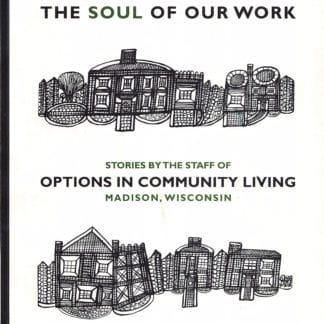A Reflective Piece – on the complexity of our systematic exclusion people with disabilities. John describes it as a “A disgrace to the nation”. He outlines the challenge ahead as we struggle to replace institutions.
John O’Brien & Connie Lyle O’Brien: Books, Articles, Videos
“A disgrace to the nation” A Turning Point in the Struggle to Replace Institutions
John O’Brien 1
Tizard Learning Disability Review 10:1, 12-17 (2005).
1 This paper was written with funding to Responsive Systems Associates, Inc from the National Institute on Disability and Rehabilitation, U.S. Department of Education awarded to University of Minnesota under Grant Number H133B031116, CFDA #84.133) and a subcontract with Syracuse University. The opinions expressed herein are those of the authors, and no endorsement by the U.S. Department of Education, the University of Minnesota, or Syracuse University should be inferred.
The consensus view of institutional improvement
In 1967, about 200,000 people, more than half of them children, lived in US public mental retardation institutions, 95% of which housed more than 500 people (Butterfield, 1969). The first report of the newly appointed President’s Committee on Mental Retardation devoted five paragraphs to their situation: 2
…Renewed attention must be given to public facilities and programs for the five percent of the mentally retarded who require full- or part-time residential care. These have not kept pace with progress in community activities on behalf of the retarded. Some of the best residential programs represent triumphs of resourceful staffs over cheerless facilities, pennypinching budgets and general indifference. Many are plainly a disgrace to the nation and to the states that operate them.
The states must meet their responsibility to plan, construct and maintain modern residential facilities for those mentally retarded needing them. They should retain architects to design facilities that will be cheerful to live in as well as promote maximum effective use of staff and other resources, provide sufficient funds to staff and operate the facilities at adequate levels, and integrate the facilities’ operation into the over-all state plan for health and welfare services. (President’s Committee, 1967, paragraphs 116-118)
The other two brief paragraphs point out that institutional facilities are generally architecturally inadequate, with many being hand-me-down tuberculosis hospitals or military installations, and that nearly twice as many people as are presently employed will be required for minimally adequate staffing.
While the influential citizens who comprised the President’s Committee did not make any explicit value statements, a consensus view of institutions can be inferred from their report.
2 Direct quotations contain words and usages that will be offensive to those who value people-first, non-stigmatising language. However, this vocabulary reflects the attitudes of the time and it would be inaccurate to change it.
- Good institutions are possible and attainable as long as budget allocations are large enough to allow the building of modern, efficient, cheerful facilities and a sufficient number of well-trained staff. The architect is the key named player in institutional improvement.
- Institutions are necessary for about 300,000 of the estimated six million Americans with mental retardation, so institutional capacity will need to grow substantially.The words denoting quality speak of modernisation, adequacy of operations, effective use of resources, and cheerfulness of surroundings. This is neither a critical understanding of institutions nor an optimistic vision for their possibilities. It takes for granted that professionals know what to do to build and operate adequately cheerful institutions as long as money and master plans are available; there is no call for new sorts of programs or for research into institutions. It simply values more of the same: more money, more staff, more facilities.
Consensus disturbed by a call for deeper change. Eighteen months after the publication of MR 67, the President’s Committee published, though it never endorsed, Changing Patterns in Residential Services for the Mentally Retarded (Kugel and Wolfensberger, 1969), a closely argued seventeen chapter call for fundamental change in services authored by fourteen men who held senior academic, government, and advocacy posts in the United States, the United Kingdom, Sweden, and Denmark. Although Changing Patterns stops short of calling for the abolition of institutions, its contents capture a turning point in the values and beliefs guiding services to people with learning disabilities. (For accounts of the development of key ideas in Changing Patterns and reflections on their influence, see Wolfensberger 1999 and Nirje, 1999.)Despite its lack of official sanction, Changing Patterns exerted considerable influence. Some parent advocacy groups shaped their thinking about service development in its terms. Lawyers involved in successfully suing states over institutional conditions drew on the publication and some of its authors to make their cases and design remedies. Some newly appointed state and regional planners and administrators used it to inform their plans. Institution professionals and their supporters contested hotly with some of its authors in court, in conferences and publications, and in planning groups, and this debate added momentum to the turn toward explicit advocacy for institutional abolition.
The logic of Changing Patterns derived from an empirically grounded theory of social change (Dybwad, 1969). First, it exposes the problems with current practice and their sources; then, it demonstrates that practical ways already exist to do better and that there are models and principles to guide systematic work toward positive change.
Consensus challenged by better working models
One part of the argument for change appeals to expert knowledge. Changing Patterns makes controversial assertions that “it is doubtful whether there is a single exemplary model of care for the severely and profoundly retarded anywhere in [the US]” (Kugel and Wolfensberger, 1969, p. 2), and that the most effective models of good practice were overseas, in Sweden, Denmark, and the UK.
Two themes –well expressed in Jack Tizard’s contribution (1969) and running through many of the other chapters– undermine the assumption that the operators of US institutions have sufficient knowledge to underwrite the investment of more money to bring existing types of facilities up to capacity or to validate the standard for institutional quality set by their professional society (AAMD Project, 1964).
- Neither the extent of demand for institutions nor their functions can sensibly be understood without a careful examination of the needs of the people served in the context of specialist and general community services. The level and type of demand for institutional services is determined by the extent and quality of local supports, including foster homes and small group residences. An available continuum of local services would substantially reduce the demand for institutional placement. Very, very few people with mental retardation require hospital treatment, and very few even require basic nursing, so planners who advocate for institutions modeled on hospitals is mistaken.
- Research on a variety of approaches to supporting people with mental retardation is essential and it would be a serious error to lock-in any particular approach to services before undertaking and comparing a variety of approaches to local services. “The main need… is for experiment –for planned variation in the pattern of a [non-institutional] service which is expanding, and for evaluation of the results obtained from different kinds of administrative practice.” (Tizard, 1969, p. 209)
Consensus disrupted by ordinary human responses
During the 1965 holiday season, Burton Blatt, a Professor of Special Education and Fred Kaplan, a photographer, visited the wards of four institutions. Kaplan used a concealed camera to document Christmas in Purgatory in more than 100 black and white photographs (Blatt and Kaplan, 1967. These pictures can and should be viewed at the internet address given in the references section; no words describe the routine horrors depicted). The editors of Changing Patterns led their formulation of the state of US institutions with Blatt’s reflections on Christmas in Purgatory.
Not only does Blatt demonstrate the depth of the institution problem, he reframes both the nature of the problem and the relevant ways of knowing where difficulties lie and where answers are to be found. The primary problem in changing institutions is not technical or fiscal, it is moral.
It is not that these attendants are cruel or incompetent people –although, all too often, they are—but they have come to believe that those in their charge are not really human… More important than the desperately needed increased per capita expenditure for institutional care, more important than the obvious necessity to reduce the size of institutions, more important than the alleviation of the now hopeless crowdedness, is the necessity of infusing a fundamental belief among all who work with the mentally retarded that each of these individuals is equally human… (Blatt, 1969, p. 46-47).
There is a place for scientific inquiry and for expert knowledge, but what is essential to changing life for the better is obvious to human senses –eyes and nose, ears and touch– and registered in human emotion –terror and sadness, anger and depression. Denial and rationalization deaden perception and excuse inaction.
It does not require a scientific background or a great deal of observation to determine that one has entered the land of the living dead; it does not require too imaginative a mind or too sensitive a nose to realize that one has stumbled onto a dung hill… it is quite irrelevant how well the rest of an institution’s program is being fulfilled if one is concerned with that part of it which is terrifying. No amount of rationalization can mitigate that which, to many of us, is cruel and inhuman treatment. (Blatt, 1969, p. 38)
Wolfensberger (1969) greatly extends the reach of Blatt’s insight by bringing sociological and historical perspectives to bear on understanding “The origin and nature of our institutional models.” He deploys the idea of models to analyze the ways that the design of a human service reflects and reinforces attitudes and role perceptions that shape what people within them can see and do. Efforts to improve things will be fruitless without awareness of the influence of role perceptions on practice and a conscious, disciplined, and relentlessly consistent choice to see and treat people with mental retardation as developing persons. Seeing and treating people as sick, as subhuman, as a menace, as an object of pity, as a burden of charity, and as a holy innocent lead to dead ends. More investment of money in settings that reinforce these models are worse than wasted; they make people more retarded. Seeing developing persons leads to more positive expectations, different physical structures, and different relationships. Table 1 outlines two contrasting models.
| Role perception… | …diseased organism | …developing person |
| Authority |
• Medical/ nursing hierarchy in charge. Authority delegated to care staff. • Medical symbols of status and rank: uniforms, titles, etc. • Physicians and nurses make decisions about non-medical aspects of life (e.g. rights and privileges, work and education opportunities, visits). | • Decentralized decision- making to assure that staff in immediate contact with residents have flexibility and freedom to make rapid decisions. • Oriented to fostering personal responsibility. Individuality, dignity, privacy, and functioning similar to nonhandicapped community age peers |
| Architecture |
• Wards designed for convenience of nursing staff. • Minimize chances to injury e.g. safety screened stairways and windows • Nursing stations as centers of staff activity and resident supervision. • Amenities, toilets, and dining areas separate “staff” from “patients”. Staff facilities superior to those for patients. |
• Homelike external and internal design with small, self- contained living units. • Family dining facilities that support staff and residents sharing meals • Bedrooms for 1-4 residents. • Plenty of space for personal possessions. • Respect for personal privacy. • Access to ordinary controls (e.g. light switches and thermostats) and typical risks with expectation that residents will be trained to act adaptively. |
| Activities and routines | • Ordinary activities labeled | • Live-in care personnel. |
|
and managed as “treatments” and “therapies” (e.g. work as “industrial therapy” records as “charts”).
• Priority on medications and physical treatments over educational interventions. • Daily routines reflect hospital practices. |
• Schedules and activities that maximize interaction between staff and residents. • Facilitate and encourage the resident’s interaction with the environment. | |
| Management dilemma | • Disappointed expectation of “cure” leads to hopelessness, treatment nihilism, and avoidance of people with substantial impairments. | • Political willingness to spend to maintain life but not to develop and maintain dignified behavior. |
In counterpoint to Blatt’s descent into Purgatory and as a guide to recognizing the developing person, Changing Patterns offers Bengt Nirje’s first written exposition of normalisation as a unifying principle to guide advocacy for better life conditions, law, policy, standards, the design of facilities, and the operation of programs:
…the normalisation principle means making available to the mentally retarded patterns and conditions of everyday life which are as close as possible to the norms and patterns of the mainstream of society.
The normalisation principle applies equally regardless of the extent of people’s mental retardation, their age, or place of residence. It has multiple implications:
- People with mental retardation deserve a normal rhythm of the day, week and year, with age-typical schedules and settings for getting-up and going to bed, eating, dressing, learning, working, relaxing, and holidaying.
- People with mental retardation deserve facilities that meet the same standards as those applied to homes, schools, and workplaces for ordinary people. People should have access to adequate income through both income and social allowances. The size of facilities should conform to what is normal in society and should not isolate people because they are mentally retarded.
- People with mental retardation need opportunities for developmentalexperiences. Services for children should have a warm atmosphere, rich sensory stimulation to nourish knowledge and abilities, and guidance and teaching from adults who know them. It is wrong for children to live in the same institutions as adults with mental retardation. Services for young people should offer opportunities for socialization and the formation of impressions of life through contacts with normal society. Adults should have the opportunity to move away from home and start a life of their own, as independently as possible. Training for young adults should assist them to become as independent in their personal daily routine as possible and to develop the skills to take part in community life as much as they can.
- People with mental retardation live in a bisexual world. They should not be segregated by sex. Marriage is an option.
- The choices, wishes, and desires of people with mental retardation should be taken into consideration and respected as much as possible. Bringing people with mental retardation together to explore and express their views is important.
In its “Action Implications”, Changing Patterns derives four concepts for residential services from the principle of normalisation (Dybwad, 1969).
- Integration: Measures and practices that maximize community participation by using ordinary facilities as much as possible and by providing needed special services and restrictions in ways that are individualized to changing needs.
- Dispersal: Avoid the congregation of larger numbers than the surrounding community can absorb and integrate. Develop a large number of small residences in various places.
- Specialization: Avoid multi-purpose facilities and focus different residences with different staff identities and different types of programming on different specified needs.
- Continuity: Family members should be involved as closely as possible in crucial decisions about services. People with mental retardation should move smoothly between types and levels of service as their needs change.
Changing Patterns captured a turn from complacency about improving institutional provision to a new standard for understanding people with learning disabilities as developing humans, equal to those who serve them and those who make the decisions that determine their living conditions. Its core ideas and values have been developed, and sometimes revised (Wolfensberger, 1999), but they remain important after 35 years.
References
AAMD Project on technical Planning in Mental Retardation (1964). Standards for state residential institutions for the mentally retarded. Monograph supplement to American Journal of Mental Deficiency, 68, 4.
Blatt, B. and Kaplan, F. (1967). Christmas in purgatory. Boston: Allyn and Bacon. [Available at www.disabilitymuseum.org/lib/docs/1782card.htm]
Blatt, B. (1969). Purgatory. In R. Kugel and W. Wolfensberger, Eds. Changing patterns in residential services for the mentally retarded. Washington, D.C.: President’s Committee on Mental Retardation. Pp. 35-49.
Butterfield, E. (1969). Basic facts about public residential facilities for the mentally retarded. In R. Kugel and W. Wolfensberger, Eds. Changing patterns in residential services for the mentally retarded. Washington, D.C.: President’s Committee on Mental Retardation. Pp. 15-33.
Dybwad, G. (1969). Action implications, USA today. In R. Kugel and W. Wolfensberger, Eds. Changing patterns in residential services for the mentally retarded. Washington, D.C.: President’s Committee on Mental Retardation. Pp. 383-428. [Available at www.disabilitymuseum.org/lib/docs/1747card.htm]
Kugel, R. and Wolfensberger, W. (1969). Changing patterns in residential services for the mentally retarded. Washington, D.C.: President’s Committee on Mental Retardation.
Nirje, B. (1999). How I came to formulate the normalisation principle. In R. Flynn and R. Lemay, Eds. A quarter century of normalisation and social role valorization: evolution and impact. Ottawa: University of Ottawa Press. Pp. 17-50.
Nirje, B. (1969). The normalisation principle and its human management implications. In R. Kugel and W. Wolfensberger, Eds. Changing patterns in residential services for the mentally retarded. Washington, D.C.: President’s Committee on Mental Retardation. Pp. 178-195. [Available at www.disabilitymuseum.org/lib/docs/1941card.htm]
President’s Committee on Mental Retardation (1967). MR 67: A first report to the president on the nation’s progress and remaining great needs in the campaign to combat mental retardation. Washington, DC: US Government Printing Office. [Available at www.disabilitymuseum.org/lib/docs/1943card.htm].
Tizard, J. (1969). Residential services within the service continuum. In R. Kugel and W. Wolfensberger, Eds. Changing patterns in residential services for the mentally retarded. Washington, D.C.: President’s Committee on Mental Retardation. Pp. 197-210.
Wolfensberger, W. (1999). A contribution to the history of normalisation, with primary emphasis on the establishment of normaliation in North America between 1967-1975. In
“A disgrace to the nation” 12 R. Flynn and R. Lemay, Eds. A quarter century of normalisation and social role valorization: evolution and impact. Ottawa: University of Ottawa Press. Pp. 51-116.
Wolfensberger, W. (1969). The origin and nature of our institutional models. In R. Kugel and W. Wolfensberger, Eds. Changing patterns in residential services for the mentally retarded. Washington, D.C.: President’s Committee on Mental Retardation. Pp. 58-171. [Available at www.disabilitymuseum.org/lib/docs/1909card.htm]




